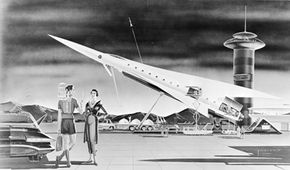The Future of Lunar Exploration
The moon has remained untouched by humans for more than four decades. In 2004, President George W. Bush vowed to send astronauts to the moon by 2020, but the Constellation program lost its funding, and the space shuttles were retired.
Thankfully though, it's no longer just governments involved in the space race -- a number of wealthy entrepreneurs also want their shot at glory. Google has offered up a $25 million prize to the first person who can send an unmanned spacecraft to the moon. To win the Google Lunar X Prize, entrants must not only land a craft on the moon but also travel 1,640 feet (500 meters) in a lunar rover and send back high-resolution video and photos from the surface of the moon.
Advertisement
At least one company is planning to sell trips to the moon to wealthy would-be astronauts. Space Adventures offers tourists trips aboard a modified Russian Soyuz spacecraft. The trip, which also includes a stay at the International Space Station, can be had for a mere $100 million.
To learn more about lunar landings, NASA and other related topics, visit our links page.
Related HowStuffWorks Articles
More Great Links
Sources
- Agle, D.C. "We called it 'The Bug.'" Air & Space, Aug/Sept 2001, pp. 60-69.
- "Apollo 11 Mission Summary." http://www.nasm.si.edu/collections/imagery/Apollo/AS11/a11sum.htm
- "The Apollo 13 Accident." NASA. http://nssdc.gsfc.nasa.gov/planetary/lunar/ap13acc.html
- "Apollo 14 Command and Service Module (CSM)." NASA. http://nssdc.gsfc.nasa.gov/nmc/masterCatalog.do?sc=1971-008A
- "The Apollo Lunar Roving Vehicle." NASA. http://nssdc.gsfc.nasa.gov/planetary/lunar/apollo_lrv.html
- Cabbage, Michael. "NASA Readies Ambitious Plans for Trips to the Moon and Mars." Orlando Sentinel, August 5, 2005.
- "The First Lunar Landing." NASA. http://history.nasa.gov/ap11ann/FirstLunarLanding/ch-1.html
- "Frequently Asked Questions: Earth's Moon." NASA. http://solarsystem.nasa.gov/faq/
- "The Great Moon Hoax." http://science.nasa.gov/headlines/y2001/ast23feb_2.htm
- Johnson, Linda A. "Company to Sell Trips around the Moon." Democrat and Chronicle, August 11, 2005.
- "Lunar Exploration Timeline." NASA. http://nssdc.gsfc.nasa.gov/planetary/lunar/lunartimeline.html
- "Lunar Roving Vehicle." http://www.nasm.si.edu/collections/imagery/apollo/lrv/lrv.htm
- "Moon Exploration." National Geographic. http://science.nationalgeographic.com/science/space/space-exploration/moon-exploration-article.html
- "Moon 'priceless' for exploration." BBC News. http://news.bbc.co.uk/2/hi/science/nature/5359312.stm
- "NASA Tests Lunar Habitat in Extreme Antarctic Environment." NASA. http://www.nasa.gov/home/hqnews/2007/nov/HQ_07251_Inflatable_Lunar_Habitat.html
- "NASA Unveils Global Exploration Strategy and Lunar Architecture." NASA. http://www.nasa.gov/home/hqnews/2006/dec/HQ_06361_ESMD_Lunar_Architecture.html
- Nichols, Robert G. "The Last Men on the Moon: The Journey of Apollo 17." Final Frontier, Nov/Dec 1992, pp. 44+.
- Schwartz, John. "Google Offers Prize for a Lunar Landing." International Herald Tribune, September 13, 2007. http://www.iht.com/articles/2007/09/13/business/prize.php
